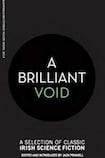
The stony grey soil of Irish letters has historically proved fallow ground for science fiction. One of the defining literary movements of the 20th century never planted meaningful roots here. Something in the national psyche mediated against gazing at the stars and wondering what it might be like to travel among them.
This was an inversion of an older trend. Early on, Ireland was represented heavily in "speculative" fiction, later to coalesce into science fiction, fantasy and horror. Both Tolkien and HP Lovecraft – one an ardent Christian, the other a devoted atheist – were indebted to the dreamy world-building of Co Meath's Lord Dunsany. Whither the modern scare story without Bram Stoker and Dracula?
But that initial flowering was chiefly an Anglo-Irish tradition and with independence it fell away. One of the few Irish science fiction writers of note from the 1950s on was Belfast-born James White, whose Sector General books are considered definitive in the “medical” sci-fi sub-genre. Twentieth-century Ireland was a cold house for a lot of people – among them authors more interested in killer robots and pirouetting space-stations than spiritual torment and property disagreements.
A secret history
There is, however, a secret history of Irish science fiction, one told passionately and diligently in a new collection from Tramp Press, edited by Jack Fennell, author of Irish Science Fiction (2014). A Brilliant Void isn't the call to arms (or phasers) frustrated Irish sci-fi devotees might have hoped for – but it is an assiduous survey of Irish imaginative writing from the Victorian era through to the 1960s.
Irish sci-fi was always its own creature as Fennell outlines in his introduction. Nineteenth-century gothic horror is the dominant sensibility in both William Maginn's breathless Mary Shelley homage The New Frankenstein (1837) and Margaret Wolfe Hungerford's The Professor's Experiment (1905) – a romp about a mad scientist seeking to control death and ageing via a fantastical anaesthetic .
Brisker and more in dialogue with an Ireland we might recognise today are the later stories, especially those translated from Irish by Fennell. In Cathal Ó Sandair's The Exile (1960), a man leaves Kerry for a lunar colony only to return to the damp old sod as a retiree.
United in obscurity
He cannot adjust to the cold (and the misery) and yearns for a long-vanished Ireland of turf fires. Meanwhile Tarlach Ó hUid's The Chronotron (1946) feels like early Doctor Who spliced with the Twilight Zone and concerns a dastardly temporal scheme to prevent the Civil War, which goes horrifically wrong (it is best enjoyed as Back to the Future meets Seán O'Casey).
Fennell is mindful of gender balance, explaining speculative fiction by women in the 19th century tended to be dismissed as fairytales (nonetheless the anthology features eight women to six men). But regardless of whether the writer was male or female, the sense is that Irish science fiction was condemned to huddle in the verges, with all the editor’s selections united in their obscurity.
Decades on from the stories compiled here, there is little evidence of the situation having changed – but why that should be is a question not within the remit of A Brilliant Void. Its task is to bear witness to those lonely pioneers who travelled far from the Irish literary heartland and discovered something remarkable out there in the emptiness.













